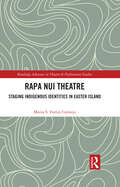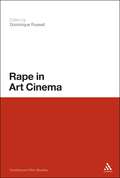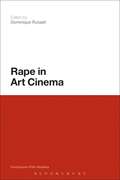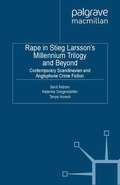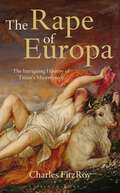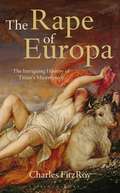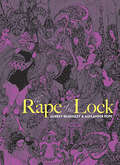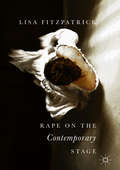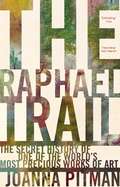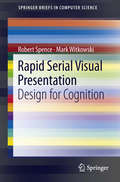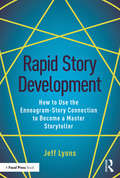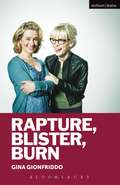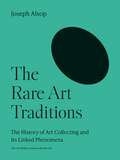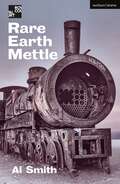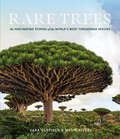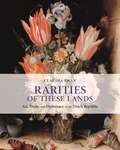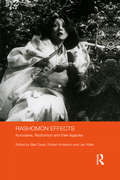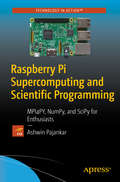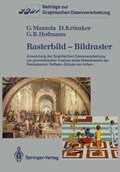- Table View
- List View
Rapa Nui Theatre: Staging Indigenous Identities in Easter Island (Routledge Advances in Theatre & Performance Studies #1)
by Moira Fortin CornejoThis book examines the relationships between theatrical representations and socio-political aspects of Rapa Nui culture from pre-colonial times to the present. This is the first book written about the production of Rapa Nui theatre, which is understood as a unique and culturally distinct performance tradition. Using a multilingual approach, this book journeys through Oceania, reclaiming a sense of connection and reflecting on synergies between performances of Oceanic cultures beyond imagined national boundaries. The author argues for a holistic and inclusive understanding of Rapa Nui theatre as encompassing and being inspired by diverse aspects of Rapa Nui performance cultures, festivals, and art forms. This book will be of great interest to students and scholars of Indigenous studies, Pacific Island studies, performance, anthropology, theatre education and Rapa Nui community, especially schoolchildren from the island who are learning about their own heritage.
Rape in Art Cinema
by Dominique RussellArt cinema has always had an aura of the erotic, with the term being at times a euphemism for European films that were more explicit than their American counterparts. This focus on sexuality, whether buried or explicit, has meant a recurrence of the theme of rape, nearly as ubiquitous as in mainstream film. This anthology explores the representation of rape in art cinema. Its aim is to highlight the prevalence and multiple functions of rape in this prestigious mode of filmmaking as well as to question the meaning of its ubiquity and versatility. Rape in Art Cinema takes an interdisciplinary approach, bringing together recognized figures such as historian Joanna Burke, philosopher Ann J. Cahill, and film scholars Martin Barker, Tanya Horeck and Scott Mackenzie alongside emerging voices. It is international in scope, with contributors from Canada, the U.S. and Britain coming together to investigate the representation of rape in some of cinema's most cherished films.
Rape in Art Cinema
by Dominique RussellArt cinema has always had an aura of the erotic, with the term being at times a euphemism for European films that were more explicit than their American counterparts. This focus on sexuality, whether buried or explicit, has meant a recurrence of the theme of rape, nearly as ubiquitous as in mainstream film. This anthology explores the representation of rape in art cinema. Its aim is to highlight the prevalence and multiple functions of rape in this prestigious mode of filmmaking as well as to question the meaning of its ubiquity and versatility. Rape in Art Cinema takes an interdisciplinary approach, bringing together recognized figures such as historian Joanna Burke, philosopher Ann J. Cahill, and film scholars Martin Barker, Tanya Horeck and Scott Mackenzie alongside emerging voices. It is international in scope, with contributors from Canada, the U.S. and Britain coming together to investigate the representation of rape in some of cinema's most cherished films.
Rape in Stieg Larsson's Millennium Trilogy and Beyond: Contemporary Scandinavian and Anglophone Crime Fiction
by Berit Åström Katarina Gregersdotter Tanya HoreckFocusing on the sexualized violence of Stieg Larsson's bestselling Millennium trilogy – including the novels, Swedish film adaptations, and Hollywood blockbusters – this collection of essays puts Larsson's work into dialogue with Scandinavian and Anglophone crime novels by writers including Jo Nesbø, Håkan Nesser, Mo Hayder and Val McDermid.
The Rape of Europa: The Intriguing History of Titian's Masterpiece
by Charles FitzRoy'The Rape of Europa' is one of Titian's great masterpieces, a work charged with eroticism and classical mystique behind which lies a tale as compelling as the painting itself. Here Charles FitzRoy weaves a unique account of its history and the painting's movement following the rise and fall of the countries in which it has been housed. The story ranges from its place at the court of King Philip II of Spain, through French revolution and English intrigue, to its final move to America, engineered by the brilliant but devious art historian Bernard Berenson. This is the tale of how Titian's masterpiece has captivated kings, nobles, artists, and lovers alike for over four centuries since its conception and continues to do so today.
The Rape of Europa: The Intriguing History of Titian's Masterpiece
by Lord Charles FitzRoy'The Rape of Europa' is one of Titian's great masterpieces, a work charged with eroticism and classical mystique behind which lies a tale as compelling as the painting itself. Here Charles FitzRoy weaves a unique account of its history and the painting's movement following the rise and fall of the countries in which it has been housed. The story ranges from its place at the court of King Philip II of Spain, through French revolution and English intrigue, to its final move to America, engineered by the brilliant but devious art historian Bernard Berenson. This is the tale of how Titian's masterpiece has captivated kings, nobles, artists, and lovers alike for over four centuries since its conception and continues to do so today.
The Rape of the Lock: An Heroi-comical Poem... (Dover Fine Art, History Of Art Series)
by Alexander Pope Aubrey BeardsleyOnly rarely in publishing history has the ideal edition of a literary work been created, where text, typography, and illustrations complement one another perfectly. Among the few examples are the Kelmscott Chaucer, Baskerville's Milton, and Beardsley's Salome. Another such book is the 1896 edition of Pope's The Rape of the Lock, illustrated by Aubrey Beardsley.Beardsley's elaborate drawings for The Rape of the Lock were created during the last phase of his brief career. This nearly Romantic period, characterized by rich, brilliantly imagined decoration and ornamentation and by high textual contrasts, was perfectly suited to the blend of mock-heroic, satire, and delicate fancy of Pope's poems. As Beardsley's biographer R. A. Walker wrote, "These drawings show a verve, a wit and appreciation of the poem than can scarcely be matched in English literature." Using his unique line and "black blot" technique, Beardsley created a masterpiece of design and mood.This Dover edition reproduces the first edition: the complete text of the five-canto poem, notes, seven full-page drawings, two half-page drawings, and the original cover design by Beardsley.
Rape on the Contemporary Stage
by Lisa FitzpatrickThis book investigates the representation of rape in British and Irish theatre since the second wave of the Women’s Movement. Mainly focusing on the period from the 1990s to the present, it identifies key feminist debates on rape and gender, and introduces a set of ideas about the function of rape as a form of embodied, gendered violence to the analysis of dramaturgical and performance strategies used in a range of important and/or controversial works. The chapters explore the dramatic representation of consent; feminist performance strategies that interrogate common attitudes to rape and rape survivors; the use of rape as an allegory for political oppression; the relationships of vulnerability, eroticism and affect in the understanding and representation of sexual violence; and recent work that engages with anti-rape activism to present women’s personal experiences on stage.
Rape on the Contemporary Stage
by Lisa FitzpatrickThis book investigates the representation of rape in British and Irish theatre since the second wave of the Women’s Movement. Mainly focusing on the period from the 1990s to the present, it identifies key feminist debates on rape and gender, and introduces a set of ideas about the function of rape as a form of embodied, gendered violence to the analysis of dramaturgical and performance strategies used in a range of important and/or controversial works. The chapters explore the dramatic representation of consent; feminist performance strategies that interrogate common attitudes to rape and rape survivors; the use of rape as an allegory for political oppression; the relationships of vulnerability, eroticism and affect in the understanding and representation of sexual violence; and recent work that engages with anti-rape activism to present women’s personal experiences on stage.
The Raphael Trail: The Secret History of One of the World's Most Precious Works of Art
by Joanna PitmanRaphael's St George and the Dragon is the work of a genius - an exquisitely rendered vision of heroism and innocence by one of the greatest painters of all time. Yet the painting's creation is only the beginning of a fascinating story that spans centuries of power play and intrigue, taking in a cast of characters both colourful and terrifying.For the young Raphael the painting was an expression of his growing talents and a crucial step in his ascent to the peak of the Renaissance art world. But for a succession of jealous owners it became a symbol of power and prestige. Painted in Italy, St George and the Dragon was sent to England as a gift for Henry VII in exchange for the prestigious knighthood of the Garter, art being traded for honour. The painting then mysteriously disappeared for a century before re-emerging as one of the key works in the great collection of art built up by Charles I, only to be sold when the collection was forcibly broken up after his execution.When Catherine the Great, a monarch of enormous appetites - political, sexual and cultural - later heard the painting was again on the market, she dispatched the famous philosopher Diderot to add it to her vast collection at the Hermitage in Russia. Treated both as an icon and as a Western masterpiece, St George and the Dragon survived fire and the Russian Revolution, only to be sold by the arch-Communist Stalin to Andrew Mellon, Capitalism's chief priest and one of the last US Robber Barons, in a secret and utterly illicit transaction.Exceptionally written and breathlessly paced, The Raphael Trail shows how the greatest beauty in art can provoke the basest instincts in man.
Rapid Serial Visual Presentation: Design for Cognition (SpringerBriefs in Computer Science)
by Robert Spence Mark WitkowskiA powerful new image presentation technique has evolved over the last twenty years, and its value demonstrated through its support of many and varied common tasks. Conceptually, Rapid Serial Visual Presentation (RSVP) is basically simple, exemplified in the physical world by the rapid riffling of the pages of a book in order to locate a known image. Advances in computation and graphics processing allow RSVP to be applied flexibly and effectively to a huge variety of common tasks such as window shopping, video fast-forward and rewind, TV channel selection and product browsing. At its heart is a remarkable feature of the human visual processing system known as pre-attentive processing, one which supports the recognition of a known image within as little as one hundred milliseconds and without conscious cognitive effort.Knowledge of pre-attentive processing, together with extensive empirical evidence concerning RSVP, has allowed the authors to provide useful guidance to interaction designers wishing to explore the relevance of RSVP to an application, guidance which is supported by a variety of illustrative examples.
Rapid Story Development: How to Use the Enneagram-Story Connection to Become a Master Storyteller
by Jeff LyonsThis book offers a unique approach to storytelling, connecting the Enneagram system with classic story principles of character development, plot, and story structure to provide a seven-step methodology to achieve rapid story development. Using the nine core personality styles underlying all human thought, feeling, and action, it provides the tools needed to understand and leverage the Enneagram-Story Connection for writing success.Author Jeff Lyons starts with the basics of the Enneagram system and builds with how to discover and design the critical story structure components of any story, featuring supporting examples of the Enneagram-Story Connection in practice across film, literature and TV. Readers will learn the fundamentals of the Enneagram system and how to utilize it to create multidimensional characters, master premise line development, maintain narrative drive, and create antagonists that are perfectly designed to challenge your protagonist in a way that goes beyond surface action to reveal the dramatic core of any story.Lyons explores the use of the Enneagram as a tool not only for character development, but for story development itself. This is the ideal text for intermediate and advanced level screenwriting and creative writing students, as well as professional screenwriters and novelists looking to get more from their writing process and story structure.
Rapid Story Development: How to Use the Enneagram-Story Connection to Become a Master Storyteller
by Jeff LyonsThis book offers a unique approach to storytelling, connecting the Enneagram system with classic story principles of character development, plot, and story structure to provide a seven-step methodology to achieve rapid story development. Using the nine core personality styles underlying all human thought, feeling, and action, it provides the tools needed to understand and leverage the Enneagram-Story Connection for writing success.Author Jeff Lyons starts with the basics of the Enneagram system and builds with how to discover and design the critical story structure components of any story, featuring supporting examples of the Enneagram-Story Connection in practice across film, literature and TV. Readers will learn the fundamentals of the Enneagram system and how to utilize it to create multidimensional characters, master premise line development, maintain narrative drive, and create antagonists that are perfectly designed to challenge your protagonist in a way that goes beyond surface action to reveal the dramatic core of any story.Lyons explores the use of the Enneagram as a tool not only for character development, but for story development itself. This is the ideal text for intermediate and advanced level screenwriting and creative writing students, as well as professional screenwriters and novelists looking to get more from their writing process and story structure.
Rapture, Blister, Burn (Modern Plays)
by Gina GionfriddoWomen are running for president. Men are exfoliating. It's all jumbled: you can't read the signs.Can any woman have it all? After university Catherine and Gwen chose opposite paths: Catherine built a career as a rock-star academic, while Gwen built a home with a husband and children. Decades later, unfulfilled in opposite ways, each woman covets the other's life, and a dangerous game begins as each tries to claim the other's territory. Sparks fly and the age-old question arises: what do women really want?Gina Gionfriddo dissects modern gender politics in this breathtakingly witty and virtuosic comedy, set in a small New England college town. Traversing the experiences of women across the generations, this play is a hugely entertaining exploration of a new style of feminism, ripe for the twenty-first century.Rapture, Blister, Burn was commissioned by Playwrights Horizons, where it premiered, with funds from the Harold and Mim Steinberg Charitable Trust. It received its UK premiere at the Hampstead Theatre, London, in January 2014.
Rapture, Blister, Burn (Modern Plays)
by Gina GionfriddoWomen are running for president. Men are exfoliating. It's all jumbled: you can't read the signs.Can any woman have it all? After university Catherine and Gwen chose opposite paths: Catherine built a career as a rock-star academic, while Gwen built a home with a husband and children. Decades later, unfulfilled in opposite ways, each woman covets the other's life, and a dangerous game begins as each tries to claim the other's territory. Sparks fly and the age-old question arises: what do women really want?Gina Gionfriddo dissects modern gender politics in this breathtakingly witty and virtuosic comedy, set in a small New England college town. Traversing the experiences of women across the generations, this play is a hugely entertaining exploration of a new style of feminism, ripe for the twenty-first century.Rapture, Blister, Burn was commissioned by Playwrights Horizons, where it premiered, with funds from the Harold and Mim Steinberg Charitable Trust. It received its UK premiere at the Hampstead Theatre, London, in January 2014.
The Rare Art Traditions: The History of Art Collecting and Its Linked Phenomena (The A. W. Mellon Lectures in the Fine Arts #27)
by Joseph AlsopA cultural and social history of art collecting, art history, and the art marketIn The Rare Art Traditions, Joseph Alsop offers a wide-ranging cultural and social history of art collecting, art history, and the art market. He argues that art collecting is the basic element in a remarkably complex and historically rare behavioral system, which includes the historical study of art, the market for buying and selling art, museums, forgery, and the astonishing prices commanded by some works of art. The Rare Art Traditions tells the story of three important traditions of art collecting: the classical tradition that began in Greece, the Chinese tradition, and the Western tradition. The result is a major original contribution to art history.
Rare Earth Mettle (Modern Plays)
by Al SmithYou don't tell an American to switch off her light; you build her a better light bulb.A leading British doctor with a radical plan to save the NHS and a Silicon Valley billionaire with a radical plan to halt climate change, meet outside an abandoned train on a salt flat in South America.A landscape so bright in its whiteness that it isn't easy to look at, and so uninterrupted in its flatness there's no echo.For Kimsa and his daughter who live there, the arrival of these strangers initially seems like an opportunity. Until they both stake their claim on the land, each following their ruthless pursuit of 'the greater good'.Al Smith's landmark play premieres at the Royal Court following his 2016 hit Harrogate which saw him nominated for Most Promising Playwright at the 2017 Evening Standard Theatre Awards.
Rare Earth Mettle (Modern Plays)
by Al SmithYou don't tell an American to switch off her light; you build her a better light bulb.A leading British doctor with a radical plan to save the NHS and a Silicon Valley billionaire with a radical plan to halt climate change, meet outside an abandoned train on a salt flat in South America.A landscape so bright in its whiteness that it isn't easy to look at, and so uninterrupted in its flatness there's no echo.For Kimsa and his daughter who live there, the arrival of these strangers initially seems like an opportunity. Until they both stake their claim on the land, each following their ruthless pursuit of 'the greater good'.Al Smith's landmark play premieres at the Royal Court following his 2016 hit Harrogate which saw him nominated for Most Promising Playwright at the 2017 Evening Standard Theatre Awards.
Rare Trees: The Fascinating Stories of the World's Most Threatened Species
by Sara Oldfield Malin RiversFilled with more than 300 color photographs, Rare Trees is a stunning survey of the world's most threatened trees.
Rarities of These Lands: Art, Trade, and Diplomacy in the Dutch Republic
by Claudia SwanA vivid account of the exoticism of the Dutch Republic at a critical moment in its cultural and political historyThe seventeenth century witnessed a great flourishing of Dutch trade and culture. Over the course of the first half of the century, the northern Netherlands secured independence from the Spanish crown, and the nascent republic sought to establish its might in global trade, often by way of diplomatic relations with the Ottoman Empire and other Muslim powers. Central to the political and cultural identity of the Dutch Republic were curious foreign goods the Dutch called "rarities."Rarities of These Lands explores how these rarities were obtained, exchanged, stolen, valued, and collected, tracing their global trajectories and considering their role within the politics of the new state. Claudia Swan’s insightful, engaging analysis offers a novel and compelling account of how the Dutch Republic turned foreign objects into expressions of its national self-conception.Rarities of These Lands illuminates the formative years of the Dutch Republic, offering a timely examination of the art, politics, and exoticism of this momentous period in the history of the Netherlands.
Rarities of These Lands: Art, Trade, and Diplomacy in the Dutch Republic
by Claudia SwanA vivid account of the exoticism of the Dutch Republic at a critical moment in its cultural and political historyThe seventeenth century witnessed a great flourishing of Dutch trade and culture. Over the course of the first half of the century, the northern Netherlands secured independence from the Spanish crown, and the nascent republic sought to establish its might in global trade, often by way of diplomatic relations with the Ottoman Empire and other Muslim powers. Central to the political and cultural identity of the Dutch Republic were curious foreign goods the Dutch called "rarities."Rarities of These Lands explores how these rarities were obtained, exchanged, stolen, valued, and collected, tracing their global trajectories and considering their role within the politics of the new state. Claudia Swan’s insightful, engaging analysis offers a novel and compelling account of how the Dutch Republic turned foreign objects into expressions of its national self-conception.Rarities of These Lands illuminates the formative years of the Dutch Republic, offering a timely examination of the art, politics, and exoticism of this momentous period in the history of the Netherlands.
Rashomon Effects: Kurosawa, Rashomon and their legacies (Routledge Advances in Film Studies)
by Robert Anderson Blair Davis Jan WallsAkira Kurosawa is widely known as the director who opened up Japanese film to Western audiences, and following his death in 1998, a process of reflection has begun about his life’s work as a whole and its legacy to cinema. Kurosawa’s 1950 film Rashomon has become one of the best-known Japanese films ever made, and continues to be discussed and imitated more than 60 years after its first screening. This book examines the cultural and aesthetic impacts of Akira Kurosawa’s Rashomon, as well as the director’s larger legacies to cinema, its global audiences and beyond. It demonstrates that these legacies are manifold: not only cinematic and artistic, but also cultural and cognitive. The book moves from an examination of one filmmaker and his immediate social context in Japan, and goes on to explore how an artist’s ideas might transcend their cultural origins to ultimately provide global influences. Discussing how Rashomon’s effects began to multiply with the film being re-imagined and repurposed in numerous media forms in the decades that followed its initial release, the book also shows that the film and its ideas have been applied to a wider range of social and cultural phenomena in a variety of institutional contexts. It addresses issues beyond the realm of Rashomon within film studies, extending to the Rashomon effect, which itself has become a widely recognized English term referring to the significantly different interpretations of different eyewitnesses to the same dramatic event. As the first book on Rashomon since Donald Richie's 1987 anthology, it will be invaluable to students and scholars of film studies, film history, Japanese cinema and communication studies. It will also resonate more broadly with those interested in Japanese culture and society, anthropology and philosophy.
Rashomon Effects: Kurosawa, Rashomon and their legacies (Routledge Advances in Film Studies)
by Robert Anderson Blair Davis Jan WallsAkira Kurosawa is widely known as the director who opened up Japanese film to Western audiences, and following his death in 1998, a process of reflection has begun about his life’s work as a whole and its legacy to cinema. Kurosawa’s 1950 film Rashomon has become one of the best-known Japanese films ever made, and continues to be discussed and imitated more than 60 years after its first screening. This book examines the cultural and aesthetic impacts of Akira Kurosawa’s Rashomon, as well as the director’s larger legacies to cinema, its global audiences and beyond. It demonstrates that these legacies are manifold: not only cinematic and artistic, but also cultural and cognitive. The book moves from an examination of one filmmaker and his immediate social context in Japan, and goes on to explore how an artist’s ideas might transcend their cultural origins to ultimately provide global influences. Discussing how Rashomon’s effects began to multiply with the film being re-imagined and repurposed in numerous media forms in the decades that followed its initial release, the book also shows that the film and its ideas have been applied to a wider range of social and cultural phenomena in a variety of institutional contexts. It addresses issues beyond the realm of Rashomon within film studies, extending to the Rashomon effect, which itself has become a widely recognized English term referring to the significantly different interpretations of different eyewitnesses to the same dramatic event. As the first book on Rashomon since Donald Richie's 1987 anthology, it will be invaluable to students and scholars of film studies, film history, Japanese cinema and communication studies. It will also resonate more broadly with those interested in Japanese culture and society, anthropology and philosophy.
Raspberry Pi Supercomputing and Scientific Programming: MPI4PY, NumPy, and SciPy for Enthusiasts
by Ashwin PajankarBuild an inexpensive cluster of multiple Raspberry Pi computers and install all the required libraries to write parallel and scientific programs in Python 3. This book covers setting up your Raspberry Pis, installing the necessary software, and making a cluster of multiple Pis. Once the cluster is built, its power has to be exploited by means of programs to run on it. So, Raspberry Pi Supercomputing and Scientific Programming teaches you to code the cluster with the MPI4PY library of Python 3. Along the way, you will learn the concepts of the Message Passing Interface (MPI) standards and will explore the fundamentals of parallel programming on your inexpensive cluster. This will make this book a great starting point for supercomputing enthusiasts who want to get started with parallel programming. The book finishes with details of symbolic mathematics and scientific and numerical programming in Python, using SymPi, SciPy, NumPy, and Matplotlib. You’ll see how to process signals and images, carry out calculations using linear algebra, and visualize your results, all using Python code. With the power of a Raspberry Pi supercomputer at your fingertips, data-intensive scientific programming becomes a reality at home.What You Will Learn Discover the essentials of supercomputingBuild a low-cost cluster of Raspberry Pis at homeHarness the power of parallel programming and the Message Passing Interface (MPI)Use your Raspberry Pi for symbolic, numerical, and scientific programmingWho This Book Is ForPython 3 developers who seek the knowledge of parallel programming, Raspberry Pi enthusiasts, researchers, and the scientific Python community.
